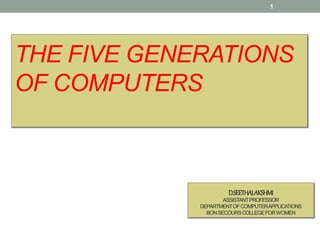
Generations of Computers.ppt
- 1. THE FIVE GENERATIONS OF COMPUTERS 1 D.SEETHALAKSHMI ASSISTANTPROFESSOR DEPARTMENTOFCOMPUTERAPPLICATIONS BONSECOURSCOLLEGEFORWOMEN
- 2. Generations of Computer • The computer has evolved from a large-sized simple calculating machine to a smaller but much more powerful machine. • The evolution of computer to the current state is defined in terms of the generations of computer. • Each generation of computer is designed based on a new technological development, resulting in better, cheaper and smaller computers that are more powerful, faster and efficient than their predecessors. 2
- 3. Generations of Computer • Currently, there are five generations of computer. In the following subsections, we will discuss the generations of computer in terms of the technology used by them (hardware and software), computing characteristics (speed, i.e., number of instructions executed per second), physical appearance, and their applications. © Educational Technology Department, Group Head Office, The City School. 3
- 4. First Generation Computers (1940-1956) • The first computers used vacuum tubes(a sealed glass tube containing a near-vacuum which allows the free passage of electric current.) for circuitry and magnetic drums for memory. • They were often enormous and taking up entire room. • First generation computers relied on machine language. • They were very expensive to operate and in addition to using a great deal of electricity, generated a lot of heat, which was often the cause of malfunctions(defect or breakdown). • The UNIVAC and ENIAC computers are examples of first-generation computing devices. © Educational Technology Department, Group Head Office, The City School. 4
- 5. First Generation Computers Advantages : • It was only electronic device • First device to hold memory Disadvantages : • Too bulky i.e large in size • Vacuum tubes burn frequently • They were producing heat • Maintenance problems © Educational Technology Department, Group Head Office, The City School. 5
- 6. Second Generation Computers (1956-1963) • Transistors replaced vacuum tubes and ushered in the second generation of computers. • Second-generation computers moved from cryptic binary machine language to symbolic. • High-level programming languages were also being developed at this time, such as early versions of COBOL and FORTRAN. • These were also the first computers that stored their instructions in their memory. © Educational Technology Department, Group Head Office, The City School. 6
- 7. Second Generation Computers Advantages : • Size reduced considerably • The very fast • Very much reliable Disadvantages : • They over heated quickly • Maintenance problems © Educational Technology Department, Group Head Office, The City School. 7
- 8. Third Generation Computers (1964-1971) • The development of the integrated circuit was the hallmark of the third generation of computers. • Transistors were miniaturized and placed on siliconchips, called semiconductors. • Instead of punched cards and printouts, users interacted with third generation computers through keyboards and monitors and interfaced with an operating system. • Allowed the device to run many different applications at one time. © Educational Technology Department, Group Head Office, The City School. 8
- 9. Third generation computers Advantages : • ICs are very small in size • Improved performance • Production cost cheap Disadvantages : • ICs are sophisticated © Educational Technology Department, Group Head Office, The City School. 9
- 10. Fourth Generation Computers (1971-present) • The microprocessor brought the fourth generation of computers, as thousands of integrated circuits were built onto a single silicon chip. • The Intel 4004 chip, developed in 1971, located all the components of the computer. • From the central processing unit and memory to input/output controls—on a single chip. • . Fourth generation computers also saw the development of GUIs, the mouse and handheld devices. © Educational Technology Department, Group Head Office, The City School. 10
- 11. Fourth Generation Computers © Educational Technology Department, Group Head Office, The City School. 11
- 12. Fifth Generation Computers (present and beyond) • Fifth generation computing devices, based on artificial intelligence. • Are still in development, though there are some applications, such as voice recognition. • The use of parallel processing and superconductors is helping to make artificial intelligence a reality. • The goal of fifth-generation computing is to develop devices that respond to natural language input and are capable of learning and self-organization. © Educational Technology Department, Group Head Office, The City School. 12
- 13. Fifth Generation Computers © Educational Technology Department, Group Head Office, The City School. 13